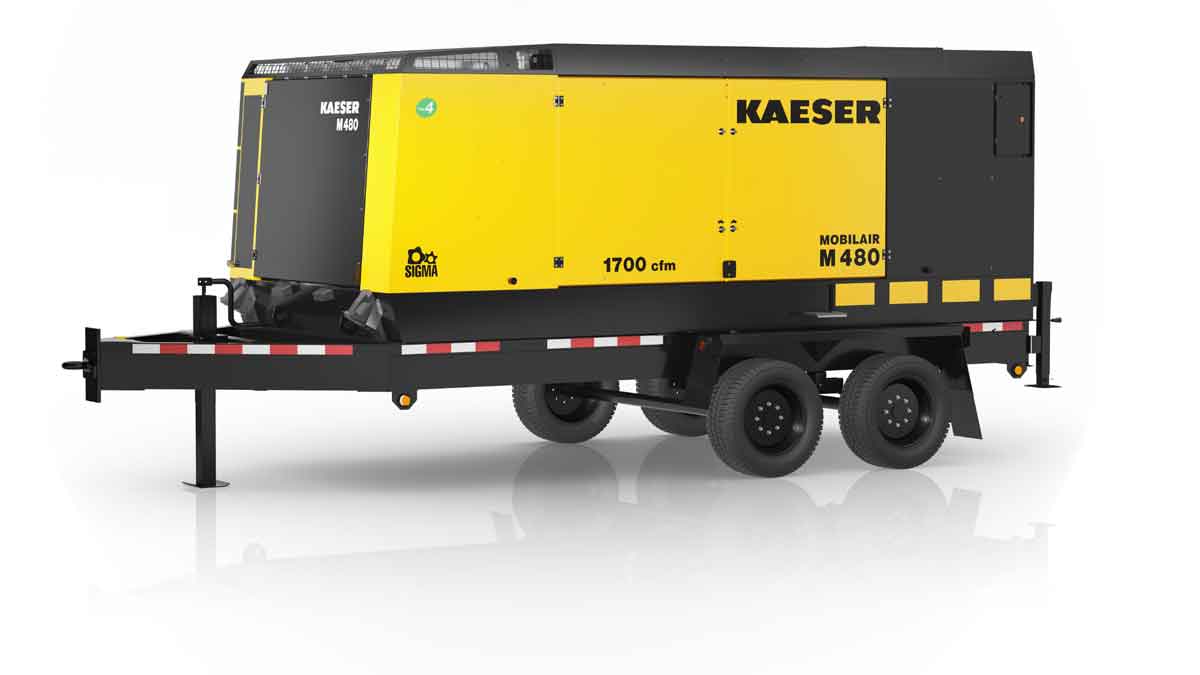Extreme Reliability
Everything necessary to the operation of a commercial truck fleet revolves around finances, and financial constraints will continue to affect fleets of all sorts for years to come. As a result, the challenge for truck fleet management is to stretch the capital outlay budget as far as possible. Additionally, though fuel prices stabilized in 2010, a failure of the economy to stabilize may result in rising fuel costs. Fuel costs and alternative fuels continue to be a crucial issue for all fleets. Fuel volatility makes forecasting a fuel budget extremely difficult. As a result, fleets are budgeting tightly and looking for ways to reduce fuel consumption in the hope fuel prices will have less of an impact on their bottom line. Picking the right vehicle-mounted air compressor can go a long way in ensuring your truck fleet’s future efficiency.
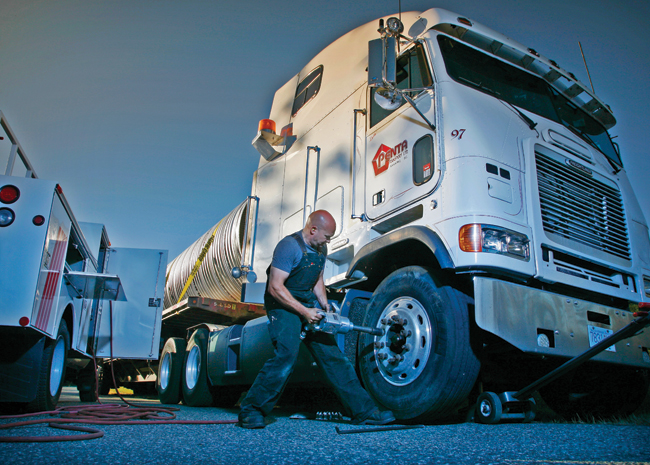
Pressure to Expand Green Fleet Initiatives
Despite budget constraints, “green initiatives” continue to gain priority throughout the public works, utility fleet and construction industry. Political support for carbon friendly, low-emission vehicle technologies, along with funding through the federal stimulus package has provided truck fleets the opportunity to acquire additional green vehicles and equipment. Support for “green” fleets is expected to continue despite increasing pressure to reduce costs. Reducing emissions and fuel consumption continue to lead the response to these initiatives. This often means looking at more fuel-efficient tools, equipment and vehicle accessories to add value to this “greening” effort.
Fleet managers continue struggling to avoid the trap of making the wrong decision for what appears to be the right green choice. One small, but important way to green your truck decisions is by choosing the right air compressor system for your fleet of chore trucks.
Consider the following example:
- Truck Mounted Diesel — A 2011 6L 300-hp diesel work truck utilizes 50 hp to produce 150 cfm and .01 g/hp-hr PM (maximum allowable emissions per EPA regulations).
- Skid Mount Diesel Drive — A 2011, 10-hp diesel engine utilizes 10 hp to produce 30 CFM at .3 g/hp-hr PM (maximum allowable emissions per EPA regulations).
A job that takes 10 minutes with the truck mounted 150-cfm air system will produce a total of .0833 g/hp-hr; whereas, the same job with the skid mounted 30-cfm compressor can take up to five times as long (50 minutes) and produce a total of 2.499 g/hp-hr. This produces 30 times more, not including additional energy and resources required in the manufacturing process to build, and eventually dispose of, two engines instead of one. A smaller, more fuel efficient system, does not necessarily mean green. Cost savings must take into account fuel, labor and the loss of resources (for example, water losses from a broken water main that can’t be repaired promptly when equipment and human resources are tied up at another job).
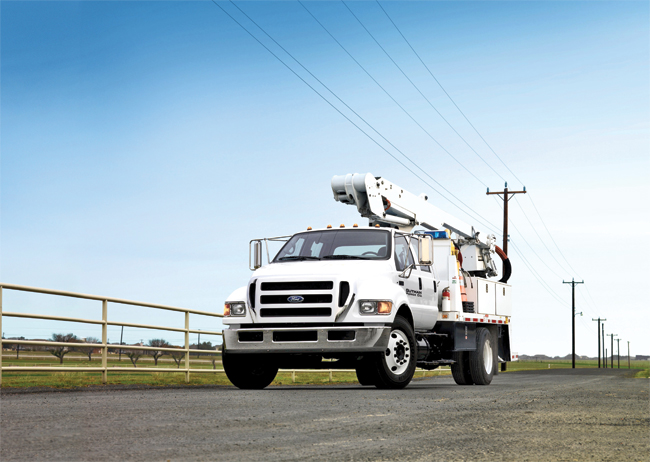
Additional info on EPA Exhaust and Crankcase Emission Factors for Engine Modeling Compression Ignition is available at https://www.epa.gov/otaq/models/nonrdmdl/nonrdmdl2004/420p04009.pdf.
Condition Extremes
Regardless of location, fleets are expected to operate in freezing climates, intense heat environments and in heavy precipitation, when demand can be greatest. Finding an air compressor that is designed for these conditions can go a long way toward addressing budgetary and environmental concerns. From fuel and lubrication to equipment readiness and the ability to perform reliably, the design and characteristic of the air compressor a fleet uses can have a direct impact on the organization’s biggest concerns. Some specific features of air compressor systems can reduce issues that might arise in extreme weather conditions:
Cold Climates
- Specially designed compressor oils — particularly synthetic blends — ensure reliable performance and reduction in equipment issues and maintenance problems.
- Pre-use preparation — such as compressor oil warming to ensure correct viscosity and appropriate hydraulic pressure (cold climate kit or digital control warming stage) — also contributes to cost savings and reduced environmental impact.
- Maintaining recommended hydraulic oil viscosity — ensures equipment longevity and reduced operating costs
Hot Environments
- ¦ Air compressors equipped with a variety of system temperature probes ensures hydraulic and compressor fluid temperatures to not exceed recommended limitations by allowing system shutdown with a safety circuit.
- ¦ Air-liquid cooling through a dual core cooler with a dedicated electric fan also prevents temperature excesses.
- ¦ Equipment color and material, such as light colors for reflecting heat and lightweight aluminum panels for superior temperature conduction, keeps equipment in ideal operating temperature range.
Heavy Precipitation
- Weatherproofed electrical connections ensure uninterrupted operation and reduced maintenance needs.
- O-rings, special weather packs and an air-tight system prevents electrical shorts and potential corrosion.
- All fasteners should be plated or stainless steel. Housings should be aluminum and all other steel items should be fully powder-coated to ensure corrosion resistance
Vehicle-Mounted Air Compressors and Extreme Weather Conditions
Given the range of services provided by public works, utility and construction fleets, performing in extreme weather conditions — intense heat, severe freezes, dangerous snow events, heavy precipitation and strong winds — is considered mandatory. The public relies specifically on public works and utility fleets for their safety in these extreme conditions. As such, fleets need to be able to rely on their vehicles, equipment and tools when these situations arise. Choosing the right vehicle-mounted air compressor can ensure reliability at these times as well as quick response while still addressing budgetary and environmental concerns.
Types of Vehicle-Mounted Air Compressors
Most vehicle-mounted air compressors offer a variety of features that allow them to perform in extreme conditions while still addressing budgetary concerns and environmental impact. Not all air compressor systems have all the necessary features, or are reliable in those circumstances. The types of vehicle mounted air compressors available that could manage these conditions include:
Gas/Diesel Drive
This is a portable or mounted, self-contained compressor system. These compressors can be found skid mounted, chassis mounted or trailer mounted, referred to as a tow behind.
- Extreme Weather Features May Include: Insulated enclosures, electric battery warmers, oil pan warmers and oversized cooler or block heaters.
- Budget Consideration: Transferability between vehicles and right-sized engines for fuel consumption.
- Environmental Benefit: Running a smaller engine reduces exhaust and fuel use with lower airflow requirements.
PTO Direct Drive and PTO Shaft Drive
Both of these air compressor systems are driven off a Power Take Off (PTO) mounted to the vehicle’s transmission or split off of the vehicle’s drive shaft. Typically these represent larger, 100-cfm plus compressors.
- Extreme Weather Features May Include: Oversized cooler. Generally open to the elements.
- Budget Consideration: Initial install costs are higher and it only utilizes the vehicle engine.
- Environmental Benefit: Powered by only one engine, requires maintenance of only one engine and has fewer enclosure components (less raw materials used).
PTO Hydraulic Underdeck
This is similar to both above deck and PTO direct drive and shaft drive underdecks. The PTO hydraulic is powered by a hydraulic pump driven by the PTO. The difference being that the components are all mounted under the vehicle, rather than on top.
- Extreme Weather Features May Include: Hydraulic tank heater or an extra hydraulic cooler.
- Budget Consideration: Initial install costs are higher, only utilizes vehicle engine and less equipment allows for purchase of an additional time, labor and money saving piece of equipment.
- Environmental Benefit: Powered by only one engine, requires maintenance of only one engine and has fewer enclosure components (less raw materials used).
Underhood
This is a rotary screw air compressor system integrated with the truck engine and fully contained under the hood. Compact and powerful, these compressors can produce up to 175 psi and up to 150 cfm.
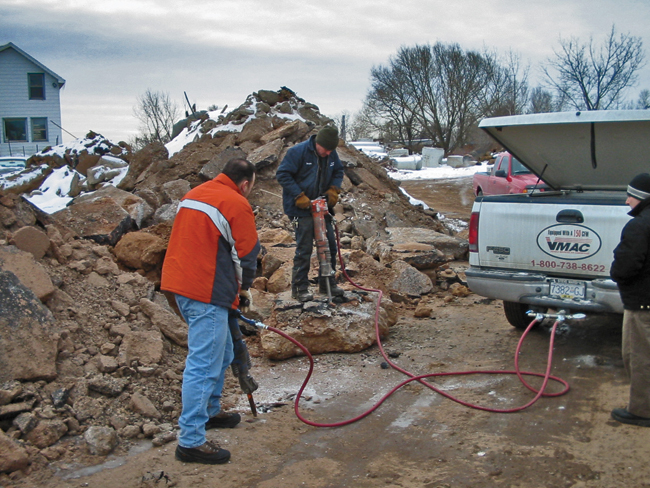
- Extreme Weather Features May Include: Because these systems are tied to the cooling system of the vehicle, in extreme weather situations they automatically benefit from the cooling function in extreme heat conditions and the heating function in extreme cold. Additionally, by being mounted under the hood they are also protected from excess precipitation.
- Budget Consideration: Uses one engine, reduced weight/payload, decreased idling and emissions, lighter weight construction material, no receiver tank, more compact size of vehicle required, reduced fuel, insurance costs less and one less piece of equipment allows for the purchase of an additional time, labor and money saving piece of equipment.
- Environmental Benefit: Uses one engine, variable speed throttle controls, reduced vehicle weight and improved equipment performance reduces fuel consumption
Hydraulic Above Deck
This may be a smaller, reciprocating type compressors or a larger, more powerful rotary screw system. Mounted on the truck deck and usually packaged in a metal enclosure. Run by hydraulic power, typically from a PTO or sometimes from an engine-driven clutch pump.
- Extreme Weather Features May Include: Automatic cold-sensing, pre-warming of hydraulic oil, soft start and cooler bypass check valve.
- Budget Consideration: All components needed to run hydraulics, initial cost of bare compressor can be lower and one less piece of equipment allows for the purchase of an additional time.
- Environmental Benefit: Throttle-Enable functions, soft start and unload and standby modes.
Conclusion
When making a choice on a vehicle-mounted air compressor system, fleet managers need to take into account their key concerns — tight budgets and environmental impact — as well as the ability of the equipment to handle extreme weather conditions that are routine for a fleet. Longevity and reduced maintenance needs contribute toward improved budgets, while proper equipment functioning reduces the environmental impact.
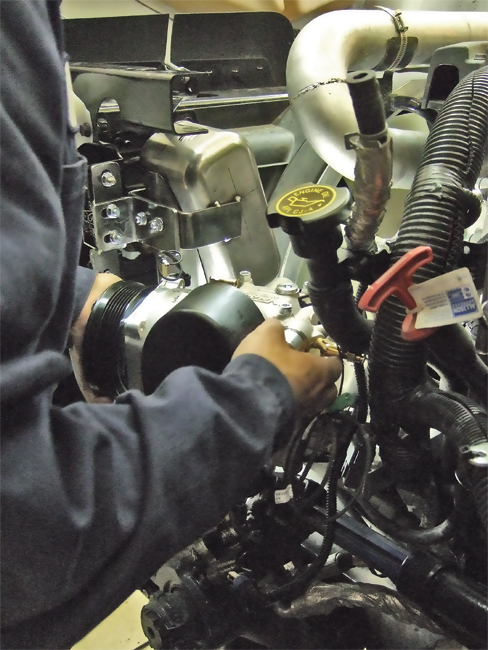
Dan Hutchinson is a product manager for VMAC (Vehicle Mounted Air Compressors), based in Nanaimo, British Columbia, Canada.
Medium-Duty Trucks with Gas Engines?
Yep. The Ford Super Duty F-650 Offers an Exclusive, Full-Efficient Gas Alternative
Budget cuts and financial restrictions are daily realities for city and town governments, so finding ways to save money is imperative. For municipalities and others seeking a cheaper alternative to replenish an aging medium-duty truck fleet, Ford offers the 2012 Super Duty F-650 with a gas engine — a class exclusive in the medium-duty truck segment. The gas variant costs thousands of dollars less than diesel trucks of its size. Class 6 and 7 medium-duty trucks are the workhorses of municipal fleets, from single-axle dump trucks to highway plow trucks.
“The gas-engine F-650 is a highly capable truck that is built Ford tough without sacrificing comfort and fuel economy,” said Todd Kaufman, F-Series chassis cab marketing manager.
The F-650 6.8-liter Pro-Loader with 19.5-in. wheels starts at $54,840 MSRP and the F-650 6.8-liter Dock Height with 22-in. wheels starts at $55,065. The average vehicle savings for an F-650 gas model compared to F-650 trucks with diesels is $8,300. The 6.8-liter three-valve gas engine renders 362 hp and 457 lb-ft of torque. The engine couples with a Ford 6R410 six-speed transmission with double overdrive gears for improved fuel economy. Further, an optional gaseous fuel preparation package is available for conversion to compressed natural gas or propane fuels if desired, another option for fleets to lower their operating costs.
The all-new F-650 is Ford-designed and Ford-built with a new interior providing comfort unexpected in a work truck.

